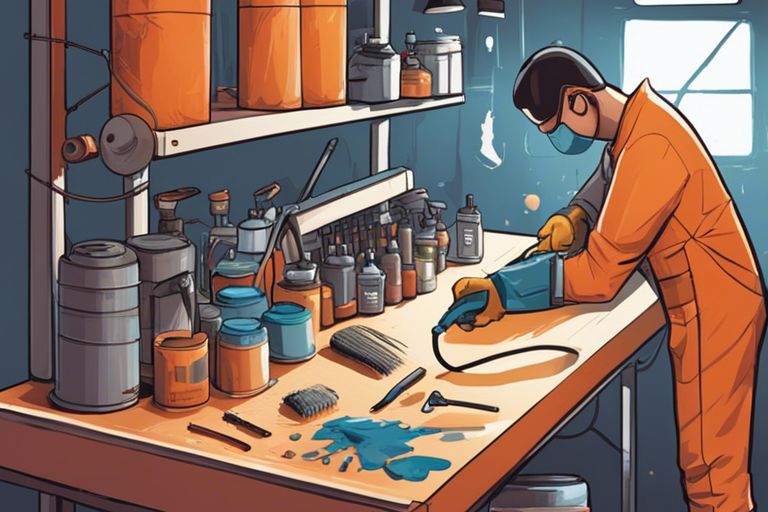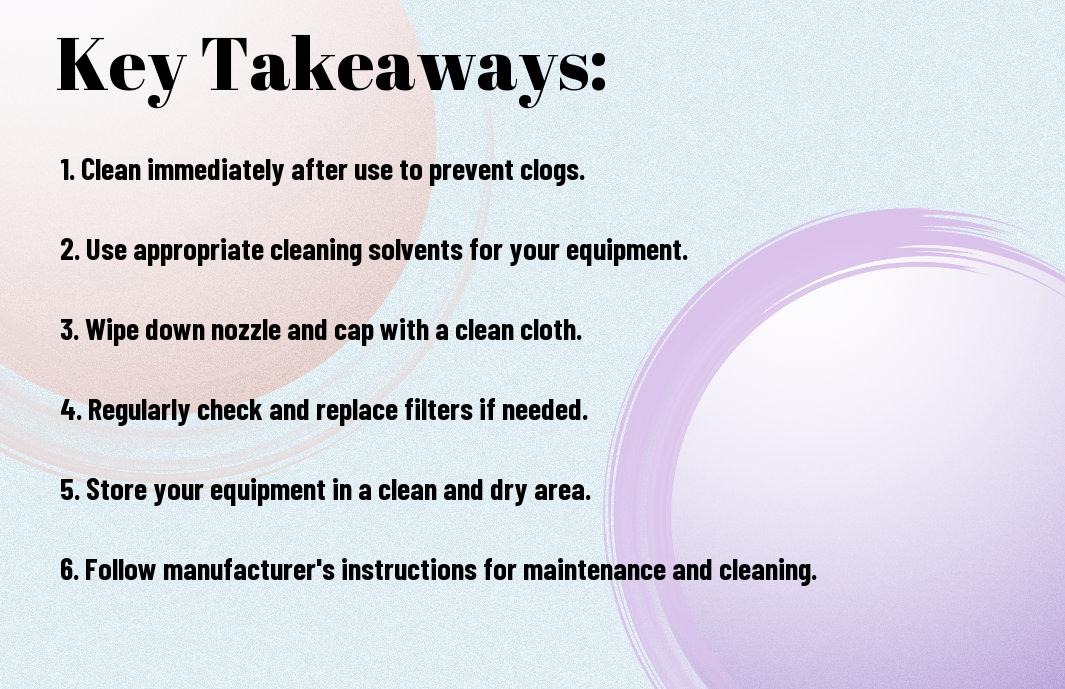Most painters often overlook the importance of proper maintenance for their spray paint equipment. To ensure your tools last long and perform efficiently, it is crucial to clean them regularly. In this guide, you will learn simple yet effective ways to clean and maintain your spray paint equipment to keep it in top shape for your next project. By following these steps, you can avoid clogs, achieve a smoother finish, and extend the lifespan of your tools. Let’s get started!
Key Takeaways:
- Clean your equipment regularly: It is important to clean your spray paint equipment after each use to prevent any clogs or build-up that could affect the performance of the equipment.
- Use appropriate cleaning solutions: Choose the right cleaning solution that is compatible with the type of paint you are using to effectively clean your spray paint equipment without damaging it.
- Proper storage is key: Store your spray paint equipment in a clean and dry place to prevent any dust or debris from settling on it and causing issues during future use.
Preparing Your Workspace
The key to effectively cleaning and maintaining your spray paint equipment is to start by preparing your workspace. This will help ensure a smooth and efficient process, allowing you to focus on the task at hand without any unnecessary distractions.
Gathering Essential Cleaning Tools
Your first step in preparing your workspace is to gather imperative cleaning tools. These typically include gloves, safety goggles, cleaning cloths, a brush or toothbrush for scrubbing, solvent or paint thinner for cleaning, and a well-ventilated area for working in. Having these tools on hand will make the cleaning process much easier and more efficient.
Protecting Your Work Area from Overspray
Gathering a drop cloth, old newspapers, or a painter’s tarp to cover and protect your work area from overspray is crucial. This simple step will not only prevent paint from getting on surfaces you don’t want it on but also make cleanup much easier once you have finished cleaning your equipment.
It is imperative to establish a designated area for cleaning your spray paint equipment to contain any overspray and prevent it from spreading to other parts of your workspace. This will help maintain a clean and organized work environment.
Disassembling Your Spray Paint Equipment
Some of the most crucial steps in cleaning and maintaining your spray paint equipment involve disassembling various components. By dismantling your equipment properly, you can ensure a thorough cleaning and prevent clogs or malfunctions during future use.
Removing the Nozzle and Cap
Any time you finish using your spray paint equipment, it’s necessary to remove the nozzle and cap carefully. These parts are prone to clogging with dried paint, which can affect the spray pattern and quality of your work. To remove them, unscrew the nozzle and cap gently, making sure not to damage the threads or the sealing components.
Taking Apart the Spray Gun and Hose
Spray guns and hoses also need regular disassembly for proper maintenance. To do this, follow the manufacturer’s instructions provided with your equipment. Taking apart the spray gun allows you to access the internal components for cleaning and lubrication, ensuring smooth operation and prolonging the lifespan of your spray paint equipment.
For hoses, disconnect them from the spray gun and air compressor carefully. Inspect the hose for any signs of wear or damage, such as cracks or leaks. Cleaning the hose regularly will prevent paint build-up, which can affect the spray pressure and overall performance of your equipment.

Cleaning the Nozzle and Cap
Many times, the nozzle and cap of your spray paint equipment can get clogged with dried paint, affecting the spray pattern and overall performance. It is crucial to clean these parts regularly to ensure smooth operation.
Soaking in Solvent
Soaking the nozzle and cap in a solvent solution is an effective way to break down and dissolve any dried paint buildup. Simply remove the nozzle and cap from the spray gun and place them in a container filled with the solvent. Let them soak for a few hours or overnight to loosen the paint residue. After soaking, use a clean cloth or brush to wipe away the dissolved paint before rinsing thoroughly with water.
Brushing Away Debris
On top of soaking, using a small brush to gently scrub the nozzle and cap can help dislodge any stubborn paint particles. Make sure to use a soft-bristled brush to avoid damaging the delicate parts. This method is especially useful for removing any remaining debris after soaking in solvent. After brushing, rinse the parts with water and allow them to dry completely before reattaching to the spray gun.
Cleaning the nozzle and cap of your spray paint equipment is crucial for maintaining its performance and longevity. By regularly soaking in solvent and gently brushing away debris, you can prevent clogs and ensure a smooth spray every time. Make it a habit to clean these parts after each use to prolong the life of your spray paint equipment.

Cleaning the Spray Gun and Hose
To keep your spray gun and hose in top condition, it is crucial to clean them regularly. Proper maintenance will ensure that your equipment functions smoothly and lasts longer. For detailed guidance on how to clean your spray gun and hose effectively, you can refer to the Sprayer Maintenance Tips & Tricks video.
Using a Cleaning Solution
On completion of your painting task, it is crucial to flush out any remaining paint from the spray gun and hose. To do this, you can use a suitable cleaning solution recommended by the manufacturer. Following the manufacturer’s instructions, fill the spray gun’s cup with the cleaning solution, and spray it through the gun until it runs clear. This process will help prevent paint buildup and clogging, keeping your equipment in optimum condition.
Rinsing with Water
Anytime you switch between different colors or finishes, it is advisable to rinse your spray gun and hose with water. This simple step can prevent color contamination and ensure the quality of your paint job. After using a cleaning solution, flush the spray gun and hose with clean water to remove any residue. Ensure thorough rinsing to avoid mixing paint colors inadvertently during your next painting project.
With these regular cleaning practices, you can maintain the performance and longevity of your spray gun and hose, ensuring consistent professional results with every use.
Drying and Reassembling Your Equipment
Air-Drying the Components
Not allowing your spray paint equipment to dry properly can lead to clogs and malfunctions. After cleaning, ensure all the components are completely dry before reassembling the sprayer.
Reassembling: Reattaching the Nozzle and Cap
Reassembling your spray paint equipment is crucial for its functionality. Start by reattaching the nozzle and cap securely to avoid any leaks or issues during your next painting project.
Any
Any loose fittings or improperly attached parts can result in a messy and disappointing painting experience. Taking the time to properly reassemble your spray paint equipment will ensure optimal performance and longevity.
Regular Maintenance Tips
Now that you’ve learned how to clean your spray paint equipment, it’s important to maintain it regularly to ensure smooth operation and longevity. Here are some tips to help you keep your equipment in top shape:
- Storing Your Equipment Properly: When you’re done using your spray paint equipment, make sure to clean it thoroughly as outlined in the previous sections. Once it’s clean, store it in a cool, dry place away from direct sunlight. This will help prevent rust and corrosion, extending the life of your equipment.
Storing Your Equipment Properly
Storing your spray paint equipment properly is crucial for its longevity. After cleaning your equipment, ensure that it is completely dry before storing it. Moisture can lead to rust and other damage over time. Additionally, consider using covers or cases to protect your equipment from dust and debris while in storage.
Scheduling Regular Cleanings
Properly maintaining your spray paint equipment also involves scheduling regular cleanings. Set aside time at least once a month to give your equipment a thorough cleaning, even if you haven’t used it recently. This will help prevent clogs and ensure that your equipment is always ready for use when you need it.
A regular cleaning routine will not only prolong the life of your spray paint equipment but also help you achieve better results in your projects. By taking care of your equipment, you’ll save time and money in the long run.

Final Words
Taking this into account, maintaining and cleaning your spray paint equipment is crucial to ensure its longevity and performance. By following the simple steps outlined in this guide, you can keep your equipment in top condition and ready for your next project. Note, a little care and maintenance go a long way in preserving your tools and helping you achieve professional results in your painting endeavors.
Q: How often should I clean my spray paint equipment?
A: It is recommended to clean your spray paint equipment after each use to prevent paint build-up and clogs. Regular cleaning will help maintain the performance and longevity of your equipment.
Q: What is the best way to clean spray paint nozzles?
A: To clean spray paint nozzles, you can remove them from the spray gun and soak them in a cleaning solution or paint thinner. Use a small brush to remove any dried paint or debris, then rinse with water and allow to dry before reattaching to the spray gun.
Q: How should I store my spray paint equipment to prolong its life?
A: To prolong the life of your spray paint equipment, make sure to clean it thoroughly after each use and store it in a cool, dry place away from direct sunlight. It is also important to properly lubricate any moving parts and regularly inspect for any signs of wear or damage.



